Does the “Be Prepared” Boy Scout motto clash with the marketing convention of buyer personas?
Buyer personas are composite sketches of whom might saddle up and ring the cash register when it comes to your company’s products or service.
How could a sweet, innocent Boy Scout run afoul of the machination of evil marketers developing buyer personas in an effort to concoct a dastardly content marketing strategy to take over the world?
You can be the reason this post gets the attention it deserves. So, if this stuff is helpful, please click the “Click to Tweet” button below.
[bctt tweet=”How could a sweet, innocent Boy Scout run afoul of the machination of evil marketers developing buyer personas in an effort to concoct a dastardly content marketing strategy to take over the world?” username=”contentwteeth”]
Regarding our poor Boy Scout, consider the Yiddish proverb that states, “We plan, God laughs.”
We can all relate. You plan for a day at the beach. Pack the sunscreen. Make the sandwiches. Get there early to snag a parking spot only to have it start raining once you unpack the beach towels.
This post aims to save the noble Boy Scout and his plans.
We strive to give you a strategy to develop buyer personas by utilizing the largest business database in the world to develop an audience with data, not guesswork or “hunches.”
Our “plan” is not foolproof but will hopefully stand up to the Great Mystery who may be indifferent to human artifice and foibles.

Why Do I Need Buyer Personas?
Most startups and young businesses fail because their product or service doesn’t align with the marketplace. In other words, they didn’t adequately research if there was demand for their product or service before diving into creating the product and hawking it.
By generating buyer personas, you research who might buy from you and know the problems they encounter and that you can solve with your product or service.
So I Plan & People Buy, Right?
Basically.
Adam Smith would approve of your intent to map buyer personas to ratchet up sales.
But how do you do it? What is the plan, Stan?
Let’s dive in with some actionable, step-by-step instruction. We start with the great marketer Herman Cain’s 5 x 5 x 5 Method.
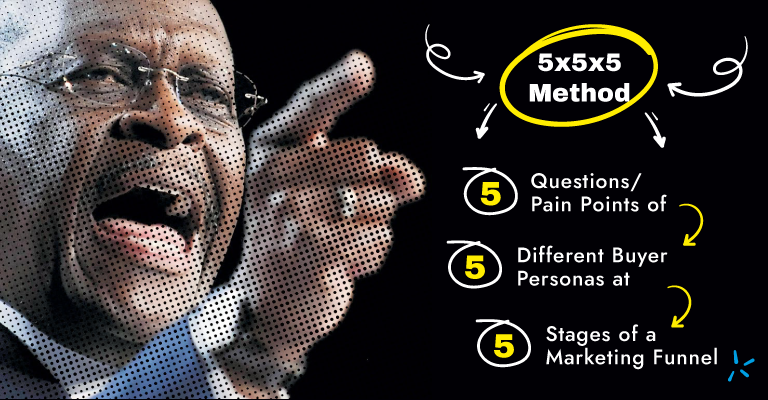
Ask yourself what are 5 questions that 5 buyer persona are asking at 5 separate stages of a marketing funnel?
A marketing funnel is the journey the buyer takes from becoming aware of your product or service all the way to the narrow bottom section where they commit to buying from you.

The 5 stages of a funnel are:
- Awareness
- Interest
- Evaluation
- Engagement
- Commitment/Purchase
So the 5 x 5 x 5 Method yields 125 total questions or subjects for content that you can produce to transform prospects into buyers.
My tweak to Herman Cain’s 5x5x5 Method (there is no doubt that the former presidential candidate and fast food Godfather created this strategy) is to amend questions with “pain points.”
Ask yourself what are the 5 problems your various buyers face from becoming aware of your product to actually buying it?
If you are introducing a product or service, you want to be a problem solver and address the issues that your target audience may have.
How to Develop a Buyer Persona
Enough with pizza politicians and instruments to imbibe fermented hops. How do you do specifically develop buyer personas?
There are ample online tools to assist you. For example, HubSpot has a buyer persona generator.
You input data and create distinct personas who may be interested in your product.

As you can see from above, HubSpot’s tool presupposes that you KNOW metrics like buyer titles and the geographic areas where they may reside.
If you’re launching your business or changing focus, you may not know these answers besides speculation.
Is there a way to determine buyer personas with actual data instead of hunches and guesswork?
Use the Power of LinkedIn to Generate a Target Audience
LinkedIn, specifically Sales Navigator, can give you a better understanding of your potential audience.
Sales Navigator is premium LinkedIn that allows you to increased search capabilities for a sales team to hone in who might be interested in their product or service.
We are asking for the “sale,” even if this content is free. If you find this information useful, tap the “Click to Tweet” button below.
[bctt tweet=”Sales Navigator is premium LinkedIn that allows you to increased search capabilities for a sales team to hone in who might be interested in their product or service.” username=”contentwteeth”]
Utilizing Sales Navigator Recommended Leads
If you have Sales Navigator, first click on the Sales Nav icon at the top right of your LinkedIn account. If you don’t have Sales Nav, stick with me. I promise to make it up to you at the end of this post.

Sales Navigator will open in another tab. The algorithm tracks your interactions on this platform and who is engaging with you. You can utilize the algo, specifically Recommended Leads, to see who might be an ideal audience.
In Sales Nav, click on “See all” under Recommended leads” in the top right portion of your screen:

This opens up 200 prospects “based on LinkedIn activity.” How do you exploit this list?
Simply scroll through the search results and look for prospects that look promising. At this point, let intuition guide you.
I scroll through my Recommended leads and see one prospect, Casey, who is co-Founder of Couchsurfing International.
Someone who helms an organization dedicated to couchsurfing is an ideal prospect for Content with Teeth. I click on the prospect’s name to view his Sales Nav profile more closely.

I examine the profile closely for cues like title and geography. Casey is/has been a Co-Founder, CEO and Founder. He is in the Bay Area. Under highlights, I can see that he is a second-degree connection. In other words, he knows people I am connected to. In this case, I look under Highlights and see we are both connected to nine mutuals.
If I wanted to connect with Casey, I could mention one of these people or ask them to introduce Casey to me.
It’s helpful to look up the target directly on LinkedIn to see other data.
Click on the three horizontal dots at the top right of the screen.

Select “View on LinkedIn.com” in the dropdown and the prospect’s profile will open up in another tab.
From here, I can see Casey’s full experience.

I right click on Casey’s company “Couchsurfing International” and select “Open link in new tab” where I see company details such as industry and employee headcount under the About tab.
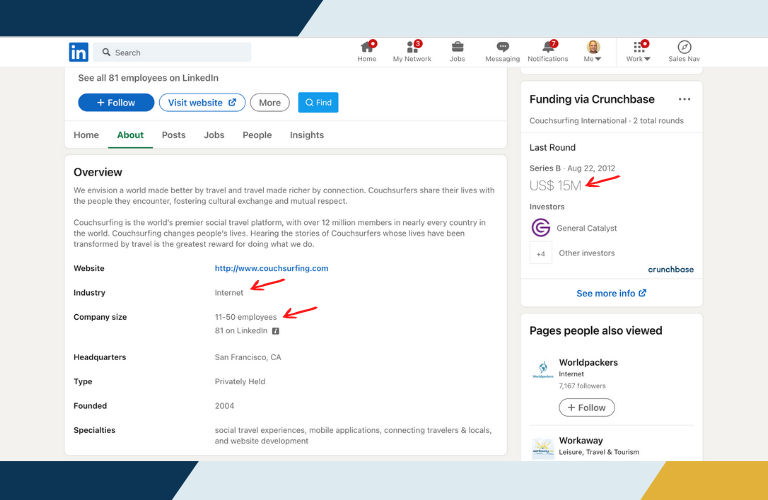
I know Couchsurfing International has under 100 employees and is an Internet company. More importantly, I see that the organization is funded. Regarding “Company size,” this is self-reported by whoever created the LinkedIn company page initially.
Know that these numbers are not iron-clad and based on hard data. Despite this, from snooping around LinkedIn and Sales Navigator, I have a greater idea who LinkedIn’s algo thinks is a good match for me.
I don’t stop with just employee headcount and industry. I scroll to the bottom of Casey’s LinkedIn profile to view his Interests.

I click on the See All button and view Influencer and Companies that Casey follows. I am particularly interested in Group that he belongs to. I click this tab.
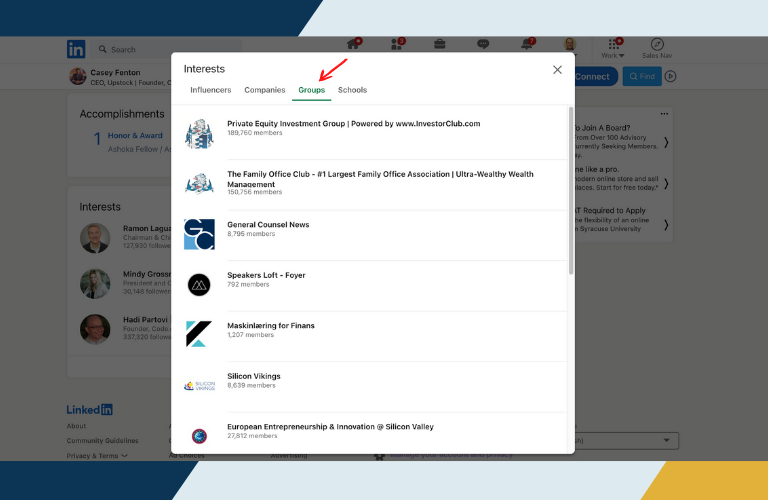
LinkedIn Groups are a key resource. I could join one of these and meet other prospects similar to Casey. As a group member, I have the ability to message other members without being directly connected to them as a first-degree or existing connection.
We will discuss utilizing LinkedIn groups to develop a content marketing strategy in a future post. Stay tuned!
Rinse & Repeat
I click back to my Sales Nav search and “rinse and repeat” this process with other promising targets. From just the first page alone, I see that 13 of the 25 prospects that Sales Nav recommends are in San Francisco. I look up other suggested leads and see what LinkedIn Groups they belong to and whether any overlap with Casey’s.
From a rudimentary glance at just the first page of results, I see that I might want to target Silicon Valley. Even though my company is based in Southwest Florida, my reach isn’t geo-limited to Florida or the Southeast United States. As a creative content agency, I can do business anywhere and might want to focus on Internet companies, primarily in San Francisco and the Bay Area.
From viewing LinkedIn recommended leads, I have a greater idea of what titles in what industry and company size to target in what geographic area. If I play around with this, I will have greater idea what to fill in the HubSpot Buyer Persona generator to generate my potential customer audience.
Utilize Existing LinkedIn Connections to Further Research Ideal Buyer Personas
You don’t have to go just by LinkedIn’s recommended leads. You can use the advanced filtering in Sales Navigator to see who looks promising in your existing or first-degree connections.
In the Sales Navigator home screen, click the Lead filters + bubble.

In the next screen, filter your search by selecting “1st Degree Connections” in the “Relationship” box.

This will bring up your existing connections. This brings up 5k prospects. I use the filter to make the list more manageable. Under “Industry,” I type in “Internet” based on what I saw above from Casey and LinkedIn’s other suggested leads.
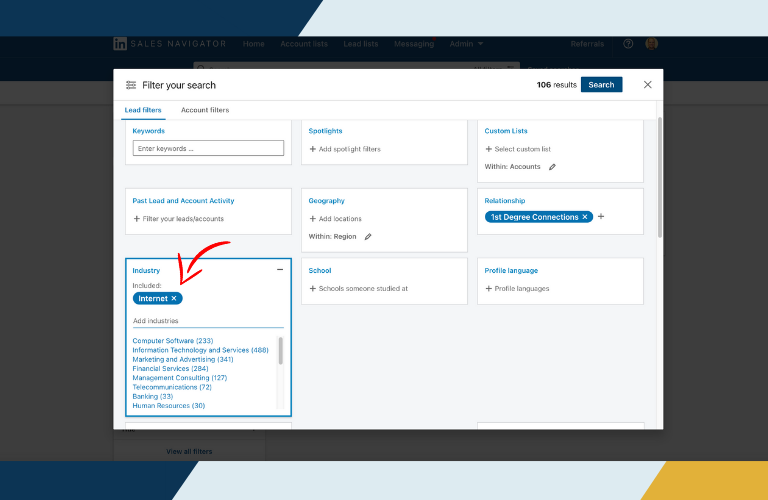
Now I have a smaller audience of people I am ALREADY connected with where I can scroll through the search and examine shared parameters like I did above.
Utilize Sales Navigator Account Filters to Further Shape Ideal Buyer Personas
You might be starting out and not have a big network. You can research new blood in Sales Navigator, and more importantly, focus on companies that are in high growth mode.
In the Sales Navigator home screen, I click on the “Account filters +” bubble.

This brings up Account filters.
I want to focus on smaller companies that are in high-growth mode with a growing employee count and surging revenue.
First, I select a revenue range of $1-10 million.
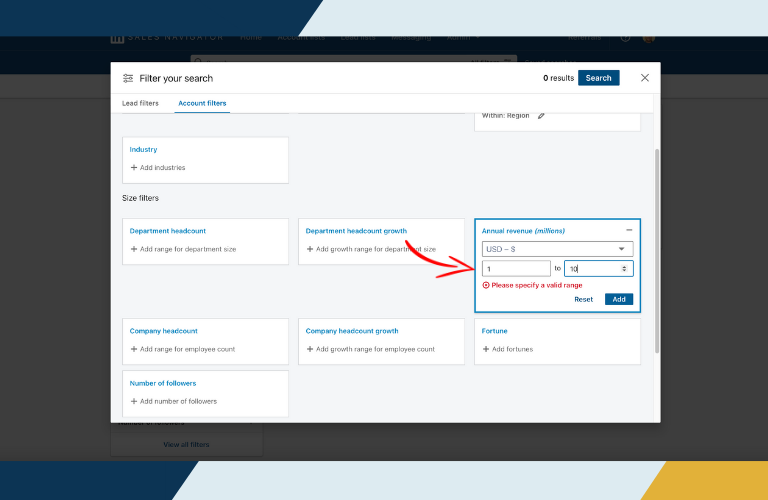
Next, I select a “Company headcount growth” between 5-40%.

This brings up nearly half a million companies, so I use the Company headcount and Geography filters to restrict my list. I search for Bay Area companies, Oakland specifically, that have between 11-50 employees.
This give me a list of 249 companies, something more targeted and manageable to work with.
I scroll and see Opera Event, an organization of social media content creators.

I have been successful getting work by partnering with other marketing companies, so I decide to investigate further. I click on “View All Employees”. I find the CEO, Brandon. I view his profile in LinkedIn.

From reading his About section, I find a potential buyer persona – CEOs and Founders in high-growth startups in the tech sector.
I examine the Opera Event LinkedIn company page. I go to the Insights tab where I see the startup is in high growth mode – 44% in 2 years.
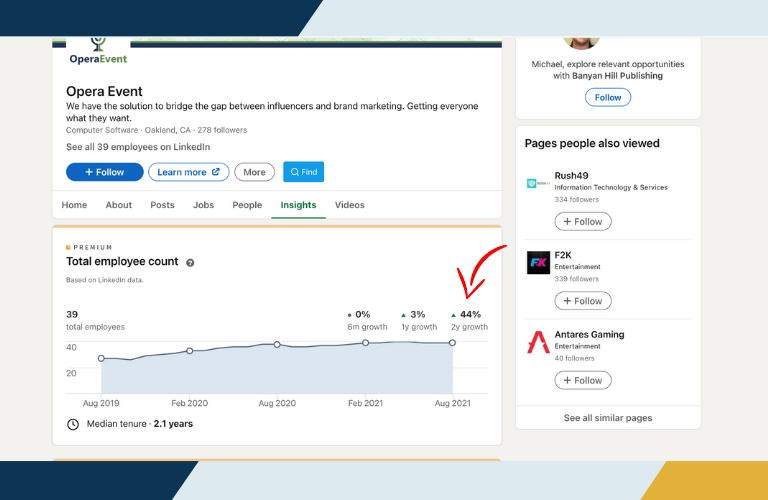
10 Minutes & I Know More About Whom Might Buy From Me
In just 10 minutes playing with Sales Navigator, I have a better idea of parameters like title, geography, industry and other factors to plug into HubSpot’s buyer personas generator to develop my audience.
A 10 minute investment on LinkedIn makes you a bulletproof Boy Scout who can yield buyer personas despite a wrathful God.
We dare you to share! If you like this content and want to support us, please tap the “Click to Tweet” button below to share on Twitter.
[bctt tweet=”A 10 minute investment on LinkedIn makes you a bulletproof Boy Scout who can yield buyer personas despite a wrathful God.” username=”contentwteeth”]
But … BUT!

I hear your cries of protestation! You don’t have Sales Navigator. I feel you. It ain’t cheap at $80/month if you pay monthly. You can sign up for Sales Navigator inside LinkedIn and get one free month.
I have a better deal where I can get you TWO months free of LinkedIn Sales Navigator. Two months free will give you enough time to try out Sales Nav to not only build your buyer personas but also do active lead generation and engage potential prospects. You can then decide whether you want to pay for it.
If you would like to hit me up for two months free of Sales Navigator, let’s chat.








